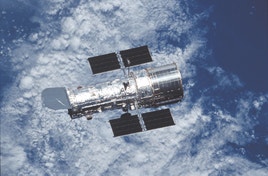Happy Birthday, Dear Hubble
April 29, 2015
(Actually, this is a belated birthday wish.) Twenty-five years ago, on April 24, 1990, the National Aeronautics and Space Administration (NASA) launched a huge telescope into space. The images it returned have given the public, as well as astronomers, a stunning view of the wonders of the cosmos.

The Hubble Space Telescope, an orbiting observatory launched in 1990, circles Earth high above the atmosphere. (NASA)
The Hubble Space Telescope is a powerful orbiting telescope that provides much sharper images of heavenly bodies than most other telescopes. It is a reflecting telescope with a light-gathering mirror 94 inches (240 centimeters) in diameter. The telescope is named after the American astronomer Edwin P. Hubble, who made fundamental contributions to astronomy in the 1920′s.
In orbit about 380 miles (610 kilometers) above Earth, the Hubble Space Telescope views the heavens without having to look through Earth’s atmosphere. The atmosphere bends light through a phenomenon known as diffraction, and the atmosphere is constantly moving. This combination of diffraction and movement causes starlight to jiggle about as it passes through the air, and so stars appear to twinkle when we view them from the ground. Twinkling blurs images seen through ground-based telescopes. Because an orbiting telescope is above the atmosphere, it can produce pictures in much finer detail than a ground-based telescope can.
Astronomers have used the Hubble Space Telescope to obtain images of celestial objects and events in detail never before observed. These include pictures of stars surrounded by dusty disks that might someday evolve into planetary systems, images of galaxies on the edge of the observable universe, pictures of galaxies colliding and tearing each other apart, and evidence suggesting that most galaxies have massive black holes in their centers.
After its launch, the Hubble Space Telescope overcame a serious defect in one of its mirrors and outlasted the U.S. space shuttle program that was used to take it into space and service it. The Hubble will amaze us with beautiful snapshots of the universe for several more years to come. Astronomers expect it to be in service past 2018, when its successor, the James Webb Space Telescope, is scheduled for launch.
Other World Book articles
- Astronomy
- Astronomy (1990-a Back in Time article)
- Seeing the Universe in a Different Light (a Special Report)


